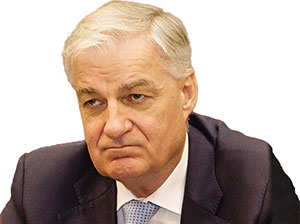Private sector crucial in financing green growth
 |
In a bid to redirect Vietnam’s economic growth onto a more sustainable path – moving away from carbon-intensive and environmentally harmful expansion – the country needs roughly $30.7 billion by 2020, and possibly some $21.2 billion for the following 10 years to support its nationally determined contribution, according to German Technical Cooperation GIZ.
To fund green growth, around 30 per cent of the capital would need to come from central and provincial coffers, and official development assistance (ODA). The remaining 70 per cent needs to come from the private sector, according to Pham Hoang Mai, director general of the Department of Science, Education, Natural Resources and Environment, under the Ministry of Planning and Investment (MPI).
“Up until now, in most countries there has been no clear figure on anticipated private investment into green growth,” said Michael Krakowski, programme director and chief technical advisor for the Macroeconomic Reforms and Green Growth Programme at GIZ.
To draw private investment to green growth ventures, green investment will first need to be defined, to unify varying opinions and bring together the appropriate sectors, Krakowski said.
“Our aim is to create a consensus from the policy side on what is considered a green investment. We can then work to create beneficial policies that conform to this consensus, taking into account the needs of society,” he told VIR.
According to Krakowski, the trade-offs between green investment and economic development are often misunderstood, especially in emerging economies. Appropriate economic policies can help balance these trade-offs.
Regarding Vietnam in particular, Krakowski said “the governmental decisions have made it clear that there should not be a trade-off between economic development and green growth, and the country is quite convinced that there is no way to further increase development without clarifying its environmental plans for sustainable growth.
“In this respect, Vietnam faces a situation where economic policy is redirected towards a more sustainable path, and this pivot is not always easy to make.”
In order to pave the way for private investments into green projects, Krakowski says a good policy framework, with incentives like feed-in tariffs, is the main driver for sustainable growth. “Take Germany as an example. We have grown our renewable energy sector with a policy framework that provides incentives for this [kind of] investment. Without any change in the incentives, there would be no private investment.”
According to Krakowski, green growth investments are, by nature, large-scale and long-term investments, putting them in the same league as other long-term investments. “It’s not specifically green investment, but rather long-term investment. And yes, the long-term risk is of course something that is quite important; you do not know what the policy framework is going to be in 20 years, and you do not know what the exchange rate is going to be in 20 years. These, to name a few, are extremely important factors for international private investment here in Vietnam.
“What we would suggest the policy-makers do is to develop measures to mitigate these risks, by creating a risk sharing scheme, or by taking over some of the risk faced by the private sector,” Krakowski told VIR, on the sidelines of a conference aimed at promoting private sector investment in green growth last week.
“The role of commercial banks and credit institutions is thus vital. And critically, the central bank plays an important part in building the legal framework to assist commercial lenders in mobilising and lending funds to green projects,” said Mai of the MPI.
Echoing Mai’s view, the State Bank of Vietnam (SBV) Deputy Governor, Nguyen Thi Hong said that “the two most important issues are resource mobilisation and the development of credit programmes, with appropriate targets in line with the criteria of green and environmentally friendly projects.”
As part of an attempt to streamline investment and lending – through the banking system – aimed at a greener and more sustainable economy, SBV Circular No. 39/2016/TT-NHNN regulating the lending operations at credit institutions and foreign bank branches – which took effect March 15, 2017 – stressed that project finance is to be conducted on the basis of negotiations between credit institutions and their clients, in accordance with lending provisions and current rules and regulations on environmental protection.
The SBV had already issued Directive 03 and Decision 1552 – to promote green credit growth and socio-environmental risk management in project finance – back in 2015.
What the stars mean:
★ Poor ★ ★ Promising ★★★ Good ★★★★ Very good ★★★★★ Exceptional
Latest News
More News
- F88 partners with MB to transform over 850 financial stores into bank offices (December 17, 2024 | 18:04)
- Obstacles to stock-market upgrade to be removed (December 17, 2024 | 11:29)
- Vietnam seizes opportunities amid global trade shifts (December 16, 2024 | 18:00)
- Long-term perspective remains optimal approach (December 16, 2024 | 14:26)
- Fiscal measures to be based on upcoming US status (December 16, 2024 | 10:09)
- PetroVietnam accelerates divestment from PVI (December 16, 2024 | 06:59)
- Techcombank proactive with ESG and sustainability (December 14, 2024 | 10:00)
- VAT cut set to continue on through to summer (December 14, 2024 | 09:00)
- BIWASE Long An issues Vietnam's first AAA-rated bonds worth $27.6 million (December 13, 2024 | 20:22)
- Citi hosts Vietnam Day for Hong Kong clients (December 13, 2024 | 14:21)















 Mobile Version
Mobile Version